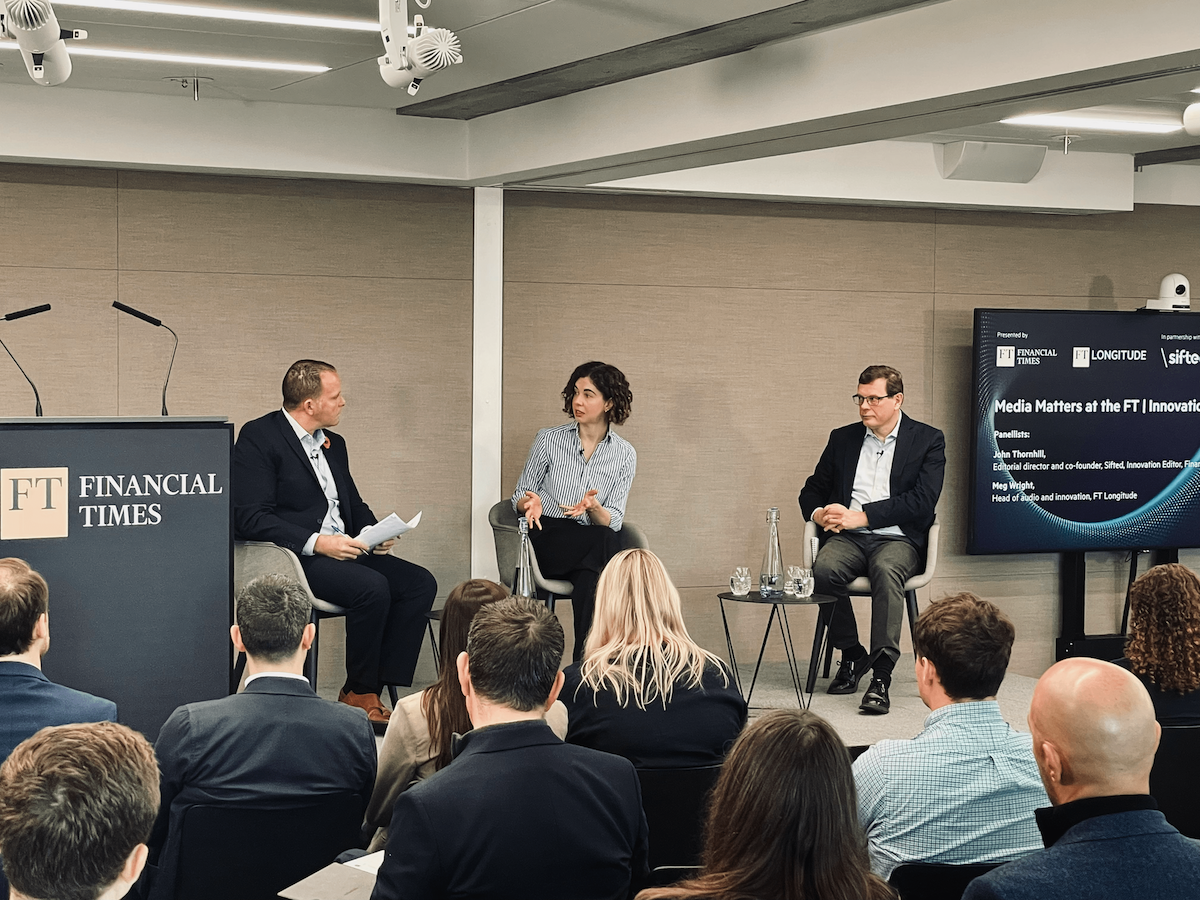Eight business themes that will shape thought leadership in 2024
Rob Mitchell
This is shaping up to be a year of accelerating tech innovation, geopolitical shifts and socioeconomic challenges. The business world could look very different by the end of it.
And as brand marketers and communicators you’re probably facing more and more scrutiny of the content you produce. Is it relevant enough? Distinctive enough? Compelling enough? Does it speak to your chosen audience, or are they switching off? The way to answer yes to these questions is to understand exactly what business leaders want to know about — and how your brand can talk about it in a new way.
Our expert editors are here to help. Subject-matter specialists in climate and natural capital, the future of work and technology, leadership and strategic innovation, and financial services, they give us their predictions for the biggest trends in business and thought leadership in 2024.
The hot themes and topics for thought leadership in 2024
Climate and natural capital
- The battle for the soul of the energy transition, Laura Adcock, Group Editor
- Offshore wind tries to get its mojo back, Candice de Monts-Petit, Senior Editor
The future of work and technology
- Bottom-up trial and error in the search for AI value, Chanice Henry, Senior Editor
- The urgent and growing need for diverse leadership, Hannah Freegard, Managing Editor
Leadership and strategic innovation
- Cyber threat actors make a splash with gen AI superpowers, Piers Tomlinson, Editorial Director
- Tensions in the leadership team as gen AI divides opinions, Peter Elkins, Group Editor
Financial services
- Digital payments finally kill off the cheque book, Jennifer Hardwick, Senior Editor
- It’s all about central banks, Justin Pugsley, Group Editor
Theme 1. The battle for the soul of the energy transition
Throughout 2024, policymakers, investors and businesses will have to make some critical calls: which decarbonisation strategies should they follow? Which energy sources should they focus on? We’ll see the debates intensify around the bankability of hydrogen projects and hydrogen’s downstream products, and see more calculations emerge that are trying to find the sweet spot for investors.
Without alternative and scalable solutions, the debate will be dominated by the use of hydrogen for industrial processes, transportation and energy storage.
Instead of perpetuating the hype, energy and industrial firms and policymakers need to make better investment decisions for a successful energy transition. To do that, they should build awareness, develop feasible business cases and commit to longer-term policies.
Our advice: Beware of greenwash. It’s not enough to just communicate ESG credentials — if they don’t stand up to intense scrutiny, your positioning could backfire. So to stand out for the right reasons, make sure your thought leadership is backed up by solid evidence.
Laura Adcock, Group Editor
Theme 2. Offshore wind tries to get its mojo back
The offshore wind sector will continue to be in the spotlight in 2024, given its vast capacity for generating zero-carbon energy. But the economic incentives for many of the market’s participants have been in decline over the past few years.
Nowhere has this been more apparent than in the UK, where the government’s Contracts for Difference (CfD) auction (also known as ‘allocation round’ or AR) failed to attract any bidders for offshore wind in 2023. The next round, AR6, is due to take place in the spring. The UK’s track record — which includes the installation of 14GW of operational wind power in its coastal waters — is impressive, but recent market dynamics have negatively affected the sector.
According to our research, conducted in collaboration with Newton Europe, 80% of people in the industry believe the UK can achieve 30GW of offshore wind power by 2030, but only 4% say it can hit its 50GW target. Nearly three-quarters worry about whether their ongoing projects can continue to be financially competitive.
In 2024, people in the industry will be evaluating the recent overhaul of the CfD mechanism and looking at policymakers’ actions to increase the UK’s manufacturing competitiveness by de-risking and near-shoring supply chains.
Our advice: Consider where to go next. Understanding how this year’s ESG themes are likely to evolve will help your company to build a sustainable, long-term narrative.
Candice de Monts-Petit, Senior Editor
Theme 3. The urgent and growing need for diverse leadership
The business landscape might be shifting rapidly, but the case for diversity in the workplace only grows. And we’re still a long way off true equity at the top.
It’s now widely recognised that diverse leadership means greater breadth of experience and perspective, which means new ways of thinking, faster innovation and fewer strategic blind spots. All that aside, a more inclusive leadership team leads to more inclusive thinking, and sets the tone for an open and equitable organisational culture.
Progress has been made, but the reality is that our boardrooms and executive teams aren’t keeping up with this perception shift. While there are promising signs of leadership gender equality improving (although there’s still a long way to go), progress on ethnic diversity in particular is lagging behind.
In 2024, leadership teams must prioritise diversity and recognise that it is crucially important because of the other challenges they face — not in spite of them.
Our advice: Research the topic. A well-designed survey can bring surprising, PR-worthy results and make you the leading voice on an issue. Here’s how Deloitte won headlines with its Women@Work campaign.
Hannah Freegard, Managing Editor
Theme 4. Bottom-up trial and error in the search for AI value
It’s easy to get carried away in the hype around AI’s potential. But businesses that take a carefully calibrated approach to AI will be the ones that generate the most return on investment from these sophisticated systems.
So where should you target your AI efforts in 2024? You’ll find the answer among your employees. Ask the teams across your business, especially the tech and AI specialists, for their suggestions of AI use cases that could solve customer problems and operational bottlenecks or even unlock new revenue streams.
A scorecard will be useful here for refining the recommendations from this discovery phase. Tracking employees’ perspectives on each use case’s benefits (scale-up potential, metric uplifts) and risks (implementation difficulties, ethical issues, cybersecurity vulnerabilities), should reveal which ones have the most potential. Make sure you verify projected returns with your finance team to work out whether forecasts from staff are realistic.
Continue taking a track and trace approach in your sandbox experimentations as you start launching AI projects, create a playbook to log your findings so learnings can be shared across the business. This track record will allow business departments to make informed decisions as they implement AI systems.
Our advice: Apply your own lens. There are sound commercial reasons to associate your brand with the biggest business themes of the day, but that doesn’t mean you have to say the same things as everyone else. Every business has its unique identity, capabilities and strategic goals that it can use to make its thought leadership content distinctive.
Chanice Henry, Senior Editor
Theme 5. Cyber threat actors make a splash with gen AI superpowers
A lot has been written about the unfolding opportunities of generative AI — often with an eye on the ‘productivity superpowers’ that companies will use it for in the years to come.
But it won’t just be business leaders taking advantage of large language models. Cyber threat actors, including criminal organisations and hostile foreign powers, will be developing innovative AI campaigns of their own. In the months ahead, they will use the technology to create increasingly sophisticated social engineering strategies, such as by setting up fake but convincing digital profiles that trick executives into divulging data to someone they have come to trust. They may even think they have been chatting online with the boss.
Another concern is that a new wave of hackers will use gen AI to overcome the traditional barriers to a career in cyber crime, such as proficiency in coding languages and understanding of data manipulation. For environmental and political protestors, cyber disruption may offer a welcome alternative to the opprobrium, injury and prosecution they face when they carry out physical protests.
For chief security, and information security officers, it’s another threat to worry about, and another reason to make sure their cyber strategies are evolving in line with new risks.
Our advice: Find the story and make it relatable. A good narrative will bring coherence to even the most complex topics and turn ideas and insights into something that your readers can act on.
Piers Tomlinson, Editorial Director
Theme 6. Tensions in the leadership team as gen AI divides opinions
The systemic implications of gen AI are so significant and complex that you’ll struggle to find consensus on the technology.
Take regulations. While the EU is powering ahead with legislation that sets clear rules for the use of AI, technology experts argue that regulation is premature and will stifle competition and innovation. Who’s right?
Gen AI also has the potential to create tensions and disagreements within a company’s leadership team. We could even see a situation where management teams are gung ho about seizing the productivity and growth opportunity of the technology, but board members want to put the brakes on until the societal and ethical implications are better understood. Leadership teams will be divided on how to balance opportunity and risk, which will be compounded by an absence of regulatory guard rails.
Of course, disagreement is a sign that companies are debating these issues thoroughly and openly, which is healthy. But there needs to be a way to reconcile viewpoints and make sure that risks aren’t ignored in all the excitement of the AI opportunity.
CEOs will need to get to grips with their approach to technology governance in 2024, and they’ll be looking to brands for ideas. Guidance on risk management, workforce education and updating technology governance frameworks to include the responsible use of AI will be especially popular.
Our advice: Keep in mind that strategic investment decisions within large corporations are typically made across a leadership team. And what matters to a CEO will be different from what matters to a chief technology officer or a finance chief. So thought leadership geared to the C-suite must take these different perspectives into account — often with separate, targeted messaging. This will be an essential part of planning your campaign.
Peter Elkins, Group Editor
Theme 7. Digital payments finally kill off the cheque book
Some countries, including the US, might still use cheques, but 2024 looks likely to be the year that digital payments assert their dominance.
Expect more global growth in contactless, mobile payments and peer-to-peer apps for consumers. And business-to-business payments won’t be far behind. With efficiency and convenience also expected more than ever in the corporate world, there’ll be more growth for real-time payments and virtual cards.
As more businesses get on board with digital solutions, the businesses they work with will have to follow suit. Companies that still struggle with legacy payments systems and outdated processes will feel intense pressure to offer more choice to their clients — commercial and otherwise. And as confidence with digital methods across generations increases, it seems inevitable that the cheque book will soon be put away for good.
Our advice: Skilful storytelling makes sense of the data and answers the “so what?” question in relation to your thought leadership. Develop headlines that answer this fundamental question before you sign off on your research. And a logical and compelling structure helps to transform abstract concepts into something that resonates with your audience
Jennifer Hardwick, Senior Editor
Theme 8. It’s all about the central banks
In 2024, all eyes will be on the central banks and whether they’ll cut interest rates as widely anticipated by the markets. But central banks have signalled greater caution, warning that the battle against inflation might not have run its course.
If interest rates do come down, it’s quite likely that there will be strong rallies in fixed-income and equity markets. Threats to that otherwise rosy narrative include further geopolitical tensions, political uncertainty, a resurgence of inflation (thanks to disruptions in energy markets/a pick-up in wage inflation) and the possibility of a hard economic landing in the west and China. Central banks have rarely managed to orchestrate a soft landing – they nearly always go too far on interest rate rises and cause recessions.
In terms of industry developments, there will be more advances in digitisation and the use of blockchains in capital markets to power faster and more efficient trade and settlements. There could be more use of tokenisation in private markets, for example, as private equity firms seek to broaden their investor bases by reaching smaller investors. In Europe, central bank digital currencies could start moving into advanced pilots, which might have implications for wholesale financial markets in areas such as currencies and bond trading.
Our advice: Often, companies produce great content, but the audience has to work too hard to extract the key ideas. If you want them to go away with one message, make sure it’s up front and easily understood. And show as well as tell: find ways to visualise your insights in formats that are easy to share and help to spark conversations.
Justin Pugsley, Group Editor
Register now for our on-demand breakfast briefing on current trends in AI and thought leadership, as part of our brand new event series.
Speak to the team
We’ll help you to navigate and overcome any challenges you currently face and learn how to get more out of your content.
Book a meeting
About the author: Rob Mitchell
Rob is our CEO and co-founder and leads FT Longitude’s strategic planning and sets the overall vision and priorities for the business. He manages the board-level relationship with FT Longitude’s parent company, the Financial Times group, and also oversees FT Longitude’s finances, people management and administration.
Prior to co-founding FT Longitude in 2011, Rob was an independent writer and editor. Between 2007 and 2010, he was a managing editor at the Economist Intelligence Unit and prior to that he was an editor at the Financial Times, where he was responsible for the newspaper’s sponsored reports, including the Mastering Management series.
 |
Tel:
+44 (0)20 7873 4770
|
Tel:
+44 (0)20 7873 4770


